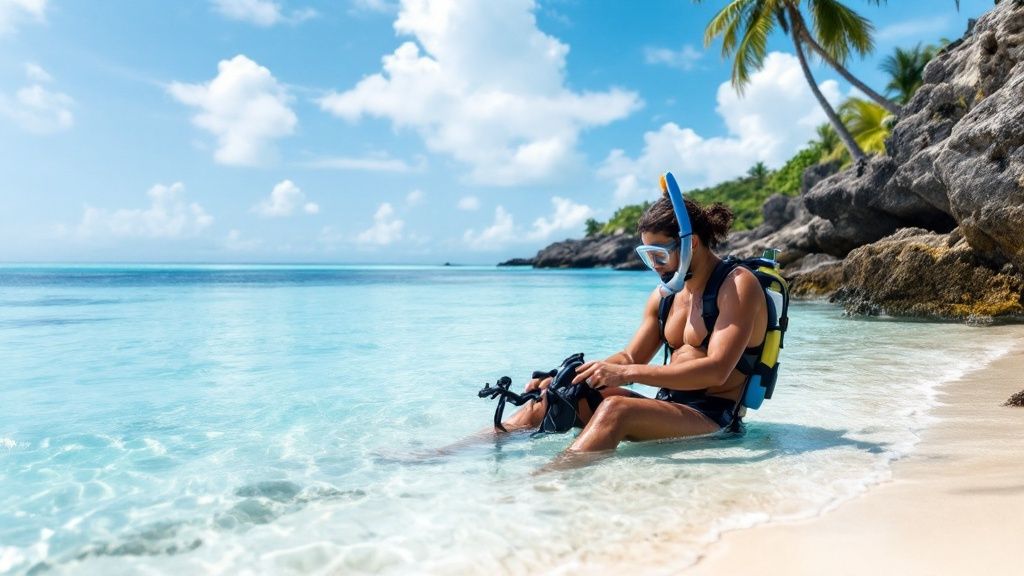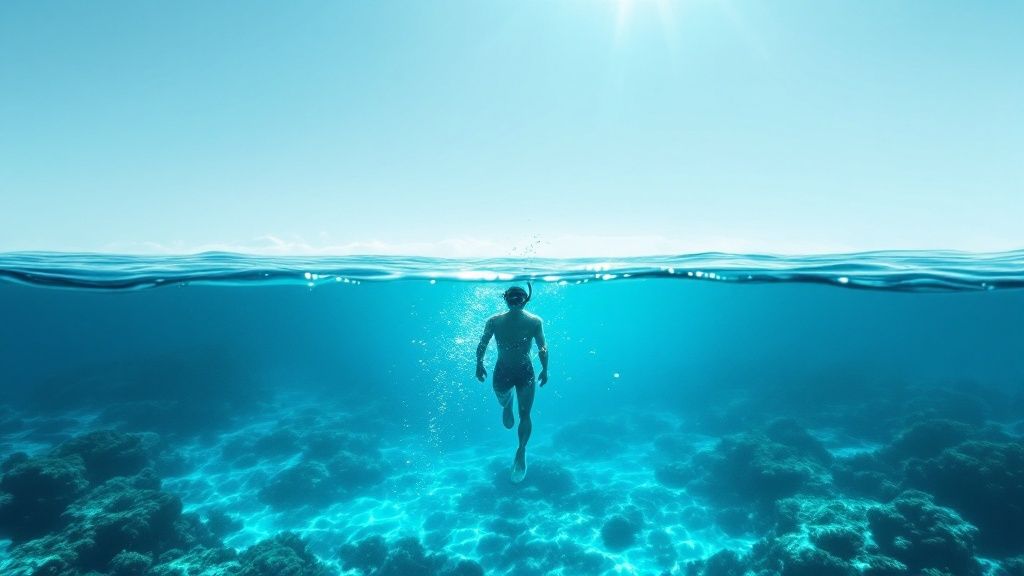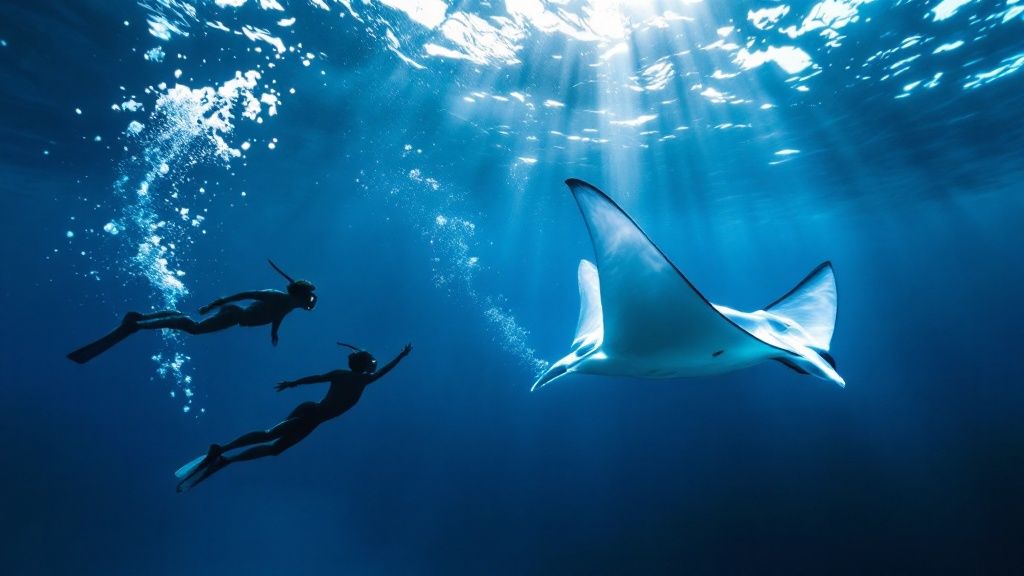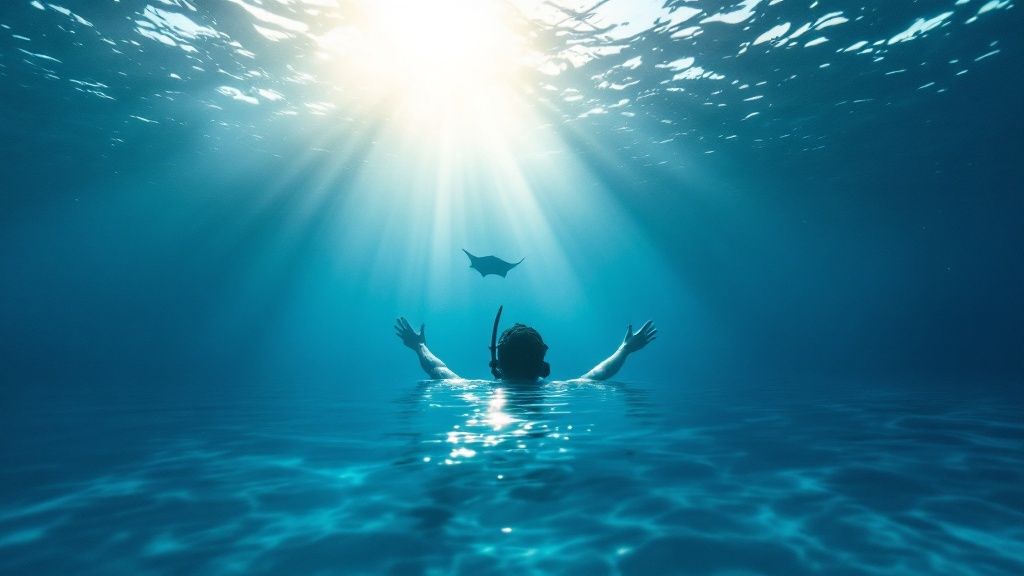Snorkeling with Manta Rays: Expert Tips & Epic Spots
- Byron
- Mar 24
- 11 min read
The Magic of Manta Ray Encounters

There's something undeniably special about sharing the ocean with a manta ray. These graceful creatures, some with wingspans over 10 feet, captivate with their effortless movements and remarkable intelligence. For many snorkelers, an encounter with a manta ray transcends mere sightseeing; it becomes a deeply moving experience, forging a profound connection with the ocean. A simple snorkeling trip can transform into a cherished memory.
The Allure of Manta Rays
Manta rays possess an undeniable allure, attracting snorkelers worldwide. Their graceful, ballet-like movements, perfected over millennia, allow them to navigate ocean currents with apparent ease. This evolutionary brilliance is truly captivating. Their intelligence is equally impressive, with documented problem-solving skills and social interactions adding to their mystique. You can explore more related content on our sitemap.
Transforming Travelers Into Advocates
These encounters often have a profound impact. Witnessing the beauty and fragility of these creatures firsthand can inspire a passion for ocean conservation. Many casual travelers find themselves transformed into ardent advocates for marine life, gaining a deeper appreciation for the interconnectedness of our planet's ecosystems.
Understanding Manta Ray Behavior
Snorkeling with manta rays is a popular activity globally, particularly in places like Hawaii and the Maldives. Along Hawaii's Kona Coast, manta ray sightings are common. From 2009 to 2014, researchers meticulously documented individual manta rays and their conditions at Manta Village and Manta Heaven. This research provided valuable insights into manta ray behavior and movement patterns within their home range. For more detailed statistics, visit Manta Ray Advocates.
Recognizing Manta Ray Species
Understanding manta ray behavior can enrich your snorkeling experience. Learning to distinguish between different species, such as the reef manta ray (Mobula alfredi) and the giant oceanic manta ray (Mobula birostris), is a great starting point. Observing their subtle behavioral cues can indicate whether a manta ray is curious or stressed, allowing snorkelers to interact responsibly and ensure a positive experience for both themselves and these magnificent animals.
Top Destinations for Manta Ray Snorkeling

Not all manta ray snorkeling destinations are equal. Some offer quick glimpses, while others provide immersive experiences. This section explores the top global locations where snorkeling with manta rays is practically guaranteed. We'll venture beyond popular spots and uncover hidden gems where you can enjoy these gentle giants with fewer crowds.
Hawaii: The Big Island's Nighttime Spectacle
Hawaii's Big Island, specifically the Kona Coast, is famous for its easily accessible night manta ray snorkeling. This unique experience capitalizes on the mantas' feeding habits. Plankton, their main food source, are drawn to light. Tour operators cleverly use underwater lights to attract plankton, which then brings in the manta rays, creating a spectacular display.
This allows snorkelers to observe these graceful creatures up close as they perform their mesmerizing feeding dances just below the surface. For more details on Hawaii's manta ray tours, see the site map.
Maldives: Year-Round Manta Encounters
The Maldives offers remarkably consistent manta ray sightings throughout the year. The diverse atolls and rich marine life create a perfect manta ray habitat. Different atolls offer prime viewing during specific seasons, optimizing your chances of an encounter regardless of your travel dates. This makes the Maldives an exceptional destination for snorkeling with manta rays, accommodating diverse travel schedules.
Indonesia: Home of the Oceanic Giants
Indonesia's islands, especially around Komodo National Park and Raja Ampat, have some of the highest populations of giant oceanic manta rays. These impressive creatures, with wingspans reaching up to 23 feet, are truly awe-inspiring.
The nutrient-rich waters around these islands provide an excellent feeding ground, attracting many mantas. In Raja Ampat, snorkelers can often see large groups of mantas feeding, creating a truly remarkable experience.
Comparing Top Destinations
To help you find the perfect spot for your manta ray snorkeling adventure, we've created a comparison table. It summarizes key aspects of each destination, highlighting the best times to visit, typical visibility, accessibility, and whether day or night snorkeling is offered.
Top Manta Ray Snorkeling Destinations Comparison: A detailed comparison of the world's best locations for snorkeling with manta rays, including optimal seasons, visibility conditions, and unique features of each destination.
Destination | Best Season | Visibility | Type of Experience | Accessibility |
|---|---|---|---|---|
Hawaii (Big Island) | April - October | Generally Good | Night Snorkeling | Easy |
Maldives | Year-round | Excellent | Day & Night | Moderate |
Indonesia | Varies by location | Good to Excellent | Day Snorkeling | Moderate to Difficult |
As you can see, each destination offers a unique experience. Hawaii is known for its easy access and night snorkeling, the Maldives for year-round sightings, and Indonesia for the chance to see giant oceanic manta rays.
Planning Your Trip
While these locations offer amazing chances to snorkel with manta rays, the ideal time to visit depends on factors like water temperature and visibility. For instance, Hawaii's dry season (April to October) usually provides calmer waters and better visibility for nighttime snorkeling.
Even outside these months, encounters are still possible. Careful planning is key to maximizing your chances of a memorable trip. Research specific dive sites and understand local tide conditions, which can significantly impact manta ray activity.
Preparing for Your Manta Ray Snorkeling Adventure

The difference between an amazing manta ray encounter and a disappointing one often comes down to preparation. This guide goes beyond the usual gear checklists, using advice from professional guides and underwater photographers to help you maximize your snorkeling adventure.
Choosing the Right Gear
Having the right equipment can significantly improve your manta ray snorkeling experience. While most tour operators provide basic gear, using your own personalized equipment can boost comfort and performance in the water.
Wetsuit Thickness: A well-fitting wetsuit is essential, especially for night snorkeling. Even in Hawaii's generally warm waters, temperatures can dip after sunset. A 3mm or 5mm wetsuit offers good thermal protection, keeping you comfortable and focused on the mantas. The added buoyancy is a bonus, too.
Mask Selection: Look for a low-volume mask with a wide field of vision. This design is important for seeing approaching manta rays in sometimes dimly lit waters. A good fit prevents leaks and distractions, allowing you to fully enjoy the experience.
Fin Type: Pick fins that provide enough propulsion without wearing you out. Open-heel adjustable fins offer flexibility and comfort, while stiff-blade fins provide more power in currents. Try different fin styles to see what works best for your strength and swimming style.
Mastering Underwater Photography Techniques
Taking great manta ray photos involves more than just pointing and shooting. Experienced underwater photographers use specific techniques to capture truly stunning images.
Camera Settings: Adjust your camera settings to match the lighting conditions. In low light, a higher ISO setting can help capture detail, but watch out for noise. Experiment with shutter speed and aperture to balance brightness and clarity.
Positioning: Don’t use flash photography, which can scare the manta rays. Instead, position yourself to make the most of the available light. Get low in the water to minimize the distance between you and the manta for maximum impact. Remember to respect the manta rays' space and avoid chasing them.
Overcoming Night Snorkeling Anxieties
Night snorkeling can be daunting for some, but with the right preparation, you can transform anxiety into excitement.
Mental Preparation: Picture yourself floating calmly in the water among these gentle giants. Deep breathing exercises can help you relax before entering the water. Understanding that manta rays are gentle filter feeders can also ease apprehension.
Choosing a Reputable Tour Operator: Select a tour operator with a strong safety record and experienced guides. Ask about their safety protocols, group sizes, and commitment to responsible wildlife interactions. These are important indicators of a quality tour. Explore our blog categories for additional resources.
Asking the Right Questions: Ask the operator about their experience, emergency procedures, and their approach to manta ray conservation. A responsible tour operator will be happy to answer your questions, showing a commitment to safety and environmental awareness. This preparation increases your comfort level and enhances the overall experience. Knowing the potential challenges, like varying visibility or water temperature, helps you prepare mentally and adapt more effectively.
Responsible Practices for Manta Ray Encounters

Planning a manta ray snorkeling trip involves more than just grabbing your gear. It's about understanding the impact we have on these graceful creatures. The future of these incredible encounters depends on responsible interactions today. That means being aware of our behavior and its effect on manta ray well-being.
Understanding the Impact of Human Interaction
Even seemingly small actions can disturb manta rays. Reaching out to touch one, while tempting, can harm their fragile skin and disrupt their protective mucous layer, vital for their immune system. Sudden movements and loud noises can also frighten them, impacting their natural feeding habits for hours.
The way divers and snorkelers interact with manta rays can significantly influence their behavior. A 2021 study discovered that oceanic manta rays responded differently to various diver actions. Active divers, making quick movements, often caused the manta rays to avoid them or end the encounter early. Read the full study here.
Passive divers, however, enjoyed longer interactions, with manta rays eventually switching from avoidance to approach behaviors. This highlights the importance of responsible diving and snorkeling to create positive experiences for both humans and these gentle giants.
Positioning for Optimal Viewing and Manta Comfort
Your position in the water greatly affects both your viewing experience and the manta ray's comfort. Instead of pursuing them, position yourself a bit ahead of their likely path and let them approach you. This minimizes disruption and allows for natural, respectful observation. For more insights, you can explore our other blog posts.
Interpreting Manta Ray Body Language
Understanding manta ray body language is key to responsible interaction. A relaxed manta ray will glide smoothly and often approach snorkelers with curiosity. A stressed manta ray, however, might display erratic movements, tightly curled cephalic fins, or sudden changes in direction. Recognizing these signs lets you adapt your behavior to prioritize their well-being.
Minimizing Sound Pollution
Research is revealing just how sensitive manta rays are to sound. They depend on sound for communication and navigation. Minimizing noise from boats and snorkeling equipment is therefore essential. Avoid banging your gear or splashing excessively, as this can disorient and stress these sensitive animals.
Becoming a Manta Ray Ambassador
By following these responsible snorkeling guidelines, we can all contribute to manta ray conservation. Share your knowledge with other snorkelers and encourage respectful behavior in the water. Be more than just a snorkeler – be an advocate for these magnificent creatures, ensuring future generations can also experience the wonder of snorkeling with manta rays.
Day vs. Night Manta Ray Snorkeling
Snorkeling with manta rays is an unforgettable experience. Choosing between a daytime or nighttime encounter, however, presents a unique dilemma. Each offers distinct advantages, creating two completely different underwater worlds. Understanding these nuances is key to planning your perfect manta ray adventure.
Daytime Encounters: Reef Life and Natural Behaviors
During the day, observe manta rays in their natural habitat, engaging in typical reef behaviors. You'll see them visiting cleaning stations, where small fish meticulously remove parasites and dead skin. Daytime snorkeling also provides glimpses into their social interactions, like courtship rituals or playful behavior, rarely seen at night. The sunlight illuminates the vibrant coral, providing a colorful backdrop for these graceful creatures.
Nighttime Encounters: The Ballet of Feeding
Nighttime offers a truly magical experience. Under the cover of darkness, tour operators use underwater lights to attract plankton, the manta ray's main food source. This creates a mesmerizing spectacle as the manta rays perform balletic feeding maneuvers in the beams of light. It's an otherworldly dance just beneath the surface. This concentrated feeding activity offers incredible close-up views. The darkness also amplifies the bioluminescence of plankton, adding a touch of magic.
Addressing Common Concerns: Visibility, Temperature, and Anxiety
Many snorkelers wonder about visibility and temperature differences between day and night. Daytime typically offers broader visibility, while the focused lights at night provide excellent close-range views. A well-fitting wetsuit, typically a 3mm or 5mm thickness, is recommended for both, ensuring comfort throughout your adventure. Nighttime excursions, in particular, may benefit from the extra warmth.
Some snorkelers experience anxiety about snorkeling in the dark. Reputable tour operators with experienced guides and robust safety procedures, such as those offered by Manta Ray Night Snorkel Kona Hawaii Tours, can alleviate these fears. Understanding the gentle nature of manta rays and proper preparation also enhance enjoyment and reduce apprehension. These operators often provide detailed briefings on manta ray biology and behavior, increasing comfort and confidence.
Choosing the Right Experience for You
To help you decide, here's a table summarizing the key differences between day and night snorkeling experiences:
To help you decide, here's a comparison of day and night snorkeling:
Factor | Daytime Experience | Nighttime Experience |
|---|---|---|
Visibility | Broader, dependent on weather conditions | Focused, illuminated by underwater lights |
Behavior | Natural reef behaviors, social interactions | Concentrated feeding, balletic maneuvers |
Atmosphere | Vibrant, active reef ecosystem | Magical, otherworldly, bioluminescent |
This table highlights the contrasting aspects of each experience, allowing you to choose the best fit for your preferences. Daytime offers a broader view of the reef and natural behaviors, while nighttime presents a focused, almost surreal feeding spectacle.
Ultimately, the best time depends on your personal preference. Some enjoy the natural behaviors and vibrant reef life of daytime snorkeling. Others are captivated by the mesmerizing feeding displays under the stars. Experienced snorkelers often recommend trying both for a truly well-rounded perspective. Each encounter provides unique and unforgettable insights into the fascinating world of manta rays.
Managing Expectations and Overcoming Challenges
Snorkeling with manta rays is an unforgettable experience. Like any wildlife encounter, however, it has its uncertainties. While careful planning is important, flexibility and a positive attitude are key to turning potential setbacks into amazing adventures.
Embracing the Unpredictable Nature of Wildlife
Even in well-known manta ray locations, sightings aren't a guarantee. Factors like weather, currents, and the mantas' natural behavior all play a role in their presence. It's important to accept this unpredictability and adopt a flexible approach. For example, unexpected currents could change the mantas' feeding patterns, or a sudden drop in visibility might make spotting them difficult.
Practical Tips for Common Challenges
Being prepared can lessen the impact of common issues. For additional help, check out our site guide: Navigating Our Website. If you're prone to seasickness, packing remedies like ginger candies or acupressure wristbands can help prevent discomfort on the boat. Having a backup plan with alternative activities is a good idea if snorkeling conditions aren't ideal.
Overcrowding, especially at popular spots, is another potential challenge. The growth of manta ray tourism has raised concerns about this. A 2010 survey of manta ray tour participants in Hawaii revealed that 78% felt crowded by boats, 82% by other snorkelers, and 69% by scuba divers. This overcrowding not only impacts the experience but also affects the manta ray habitat. More detailed statistics are available here. Choosing tours that prioritize smaller groups and responsible practices helps create a more sustainable and enjoyable experience.
Managing Anxiety in the Open Water
Open water, especially at night, can be anxiety-inducing for some. Practical preparation can help. Familiarize yourself with the snorkeling gear beforehand and choose a reputable tour operator with experienced guides. This can significantly reduce any apprehension. Deep, controlled breathing and focusing on the beauty of the surrounding marine life are also effective techniques for managing anxiety in the water. Visualizing a positive interaction with the manta rays can also boost confidence and excitement.
Shifting Your Focus: Finding Wonder in the Unexpected
Even if manta ray sightings are short, there's still plenty to appreciate. Shifting your focus to embrace the whole marine ecosystem can transform potential disappointment into a sense of wonder. Observe the diverse fish, the vibrant coral reefs, and the fascinating interplay of light and shadow in the water. This broader perspective enriches the overall snorkeling experience and creates a deeper connection with the ocean. Experienced snorkelers often share stories of how they turned challenging moments into lasting memories by focusing on the unexpected beauty they found. They emphasize that preparation, a flexible attitude, and an appreciation for the entire underwater world are key to a truly rewarding experience.
Experience the magic of manta rays with Manta Ray Night Snorkel Kona Hawaii Tours! We offer unforgettable nighttime snorkeling adventures on the Big Island, with expert guides, small group sizes, and a focus on responsible manta ray interactions. Book your tour today and create memories that will last a lifetime! Book Now!
Comments